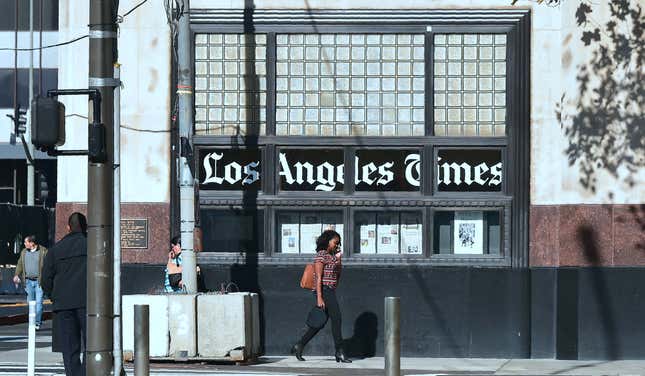
For more than a hundred years, the Los Angeles Times has been charged with telling the story of a city—one that was seized from Mexico in 1848 and has, in the 170 years since, experienced no small number of demographic shifts and racial unrest.
In an op-ed published on Sunday, the Times editorial board acknowledged that it has regularly failed in that mission, particularly as it regards the stories of Angelenos of color.
“While the paper has done groundbreaking and important work highlighting the issues faced by communities of color, it has also often displayed at best a blind spot, at worst an outright hostility, for the city’s non-white population, one both rooted and reflected in a shortage of Indigenous, Black, Latino, Asian and other people of color in its newsroom,” the editorial board wrote.
“On behalf of this institution, we apologize for The Times’ history of racism. We owe it to our readers to do better, and we vow to do so.”
The op-ed comes as many newsrooms across the country, including America’s most respected journalistic institutions, have had to publicly grapple with their shortcomings covering race and racism. The Times article also accompanies a public letter from the paper’s current owner, Dr. Patrick Soon-Shiong, vowing to increase diversity at the Times. Together, they constitute one of the more substantial public “reckonings” by a major American news publication in the last few months.
“The Times has also mirrored, and in some cases propagated, the biases and prejudices of the world it covers, reflecting and shaping attitudes that have contributed to social and economic inequity,” Soon-Shiong wrote. “Today, we are beginning the process of acknowledging those biases of the past and taking positive action to affirm a commitment that our newsroom will not tolerate prejudice.”
The Times’ editorial board reflects on the history of the LA paper from its founding, noting that founder Harrison Gray Otis, while a “Lincoln Republican” who fought on behalf of the Union and opposed slavery, also actively used the paper to “shape and dominate the region,” particularly in favor of the business interests of rich, white settlers and business owners. This chronology is a welcome tonic to a claim contemporary journalists often repeat: that neutral, “objective” stances are a bedrock of American journalism. In fact, American media organizations have cycled through different styles, approaches and values throughout their history.
This chronology also makes clear why the paper missed such important stories as the great wave of Black migration to the city that helped reshape it, as well as the Times’ expressed support of racist, xenophobic policies like the forced incarceration of Japanese Americans: “the newspaper remained nearly entirely white in its staff, its readership and its outlook.”
“Newspapers are described as a first rough draft of history. But in truth, the first rough draft written by this newspaper—and those across the country—has been woefully incomplete,” the editorial board wrote.
These include stories about the “zoot suit riots,” in which a mob of white U.S. servicemen, off-duty police officers and civilians attacked Mexican Americans and other ethnic minorities wearing “zoot suits”; police abuse; the LA uprisings; and President Dwight Eisenhower’s “Operation Wetback,” which used “military-style tactics” to deport Mexican immigrants, some of whom were U.S. citizens.
Institutional change came in fits and starts at the paper. Its highwater mark for diversity didn’t come until the early aughts when the LA Times saw three Black editors on its masthead (John Carrol, Dean Baquet and Janet Clayton) and two Latinos (Frank del Olmo and Andrés Martinez). But even that was short-lived.
Several mainstream publications, including the Washington Post and CNN, have publicly spoken on their need to expand their coverage of race this year. Large racial disparities in coronavirus outbreaks and COVID-19 deaths helped illuminate how race and ethnicity define lived experiences in the U.S.—leaving underserved and underfunded communities particularly vulnerable to the disease’s worst outcomes. The death of George Floyd in Minneapolis at the hands of police, along with the high-profile killings of Ahmaud Arbery and Breonna Taylor also highlighted the need for newsrooms to improve their coverage of stories where race and racial justice were core components.
In July, CNN announced an expansion of their team covering race. The Post announced more than a dozen newsroom positions focused on race and identity, as well as its workforce demographics. The New York Times also committed to developing strategies to hire, develop, support and promote people of color within its ranks.
Summarizing its public apology, the LA Times wrote that, while a newsroom “should not be defined by its failures,” it “must acknowledge them if it is to hope for a better future.”
Publisher Soon-Shiong, the paper’s first nonwhite publisher, said the national reckoning on race has led to “welcome developments” at the Times.
“We are committed to change, both because it is just and because it is mission-critical for our business,” he wrote. “Only a diverse newsroom can accurately tell this city’s stories. Only a newspaper that holds power to account and uncovers injustice can truly succeed.”

